6 Exercises You Can Do with a Fitball
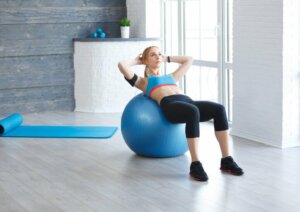
Also known as a Pilates ball, this giant rubber ball is an amazing ally for training, whether it’s at home or in a gym class. Fitball exercises are designed to be effective for everyone, and while some exercises are a little more complicated than others, you can always adapt them to suit your level.
Below, we’ll show you some of these exercises so you can include them in your workout. Among other advantages, they’ll help you to strengthen your whole body and will help to prevent injuries.
The best exercises with a fitball
These days, it’s clear that there are no valid excuses for not exercising. You don’t even have to go to the gym to get into shape; you can exercise right in your own home with just some basic items. The fitball is one of the most useful items for your home exercise kit, whether it’s for teens, adults, or older people.
There are a whole bunch of exercises you can do just on your own with a fitball, although it’s always a good idea to consult with an instructor to avoid injuries or muscle pain due to incorrect technique. Among the best options for training with a fitball, you can find the following exercises:
1. Glute bridge exercises using a fitball
This exercise is good for working your abs, glutes, and hamstring muscles. How can you do it? Lie down on an exercise mat face-up, and put your arms on the floor alongside your body for support with your palms facing downward. Put your heels on the fitball and roll it closer toward you by bending your knees. Your back should be flat on the floor.
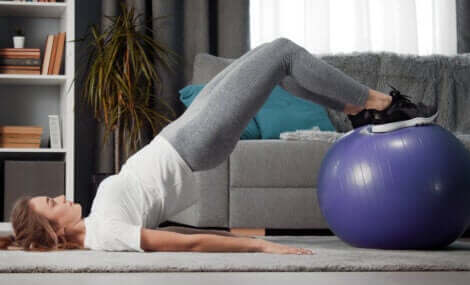
Once you’re in that position, slowly raise your buttocks off the floor. Your legs should be slightly bent at the knees and your shoulder blades should give you support on the floor. Straighten your body until it’s in a straight line between your shoulders and your knees, making sure you don’t curve your back at any time. Hold the position for a few seconds and lower your back onto the floor again.
2. Sit-ups
This exercise is really just a classic sit-up with a twist, but the great thing about doing it using a fitball is that you make your core work to improve your balance as well. The first step is to lie on the fit ball on your back, with your glutes in the air. Bend your knees so they’re at about a 90-degree angle.
Put your hands behind your head and lift your chest and shoulders off the ball, keeping your lower back in contact with it, as you can see in the opening image. Look straight ahead and lower your chin onto your chest as much as possible. Relax, leaning back onto the fit ball. Do ten reps.
3. Squats
This is one of the best exercises to do with a fitball since it allows you to work your lower body very effectively. First, stand with your back to a wall and put the fitball between your back and the wall. The idea is to press it against the wall.
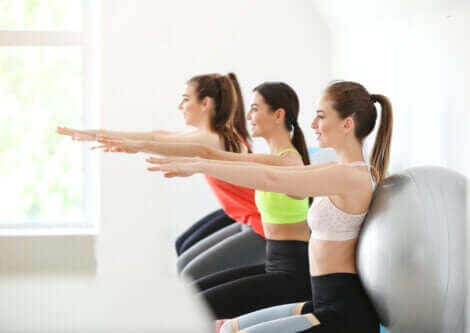
Once you’re in the starting position, bend your knees until they’re at around 90 degrees. Straighten up slowly. You can put your hands behind your head if it helps you with your balance.
Once you’ve got the hang of this exercise, you can make it a little more complicated. How? By using a couple of hand weights. Hold on to them and keep your arms hanging by your side while you do this exercise.
4. Push-ups
You can also do the famous push-ups with a fitball. This exercise is really a complete upper body workout.
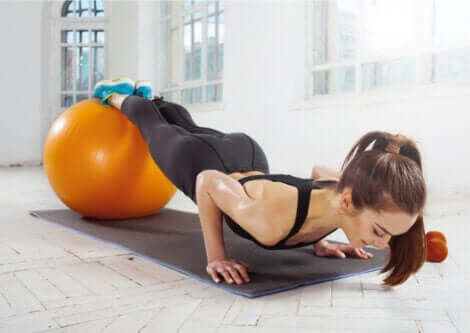
To start, lie down face-down on your exercise mat. Straighten your arms and put your feet on the fitball. If you’re on your own, you might find it helpful to put the fitball up against a wall.
Keep your legs and back straight, with just your feet resting on the fitball. Now you just need to do the push-ups by straightening and bending your arms to complete the exercise.
5. Leg flexes
Exercises using a fitball are great to improve your posture, coordination, and balance. With this exercise, you’ll be working on all of those aspects.
Firstly, put the fitball against a wall and stand with your back to it. Then, stretch your right leg backward and rest it on the ball, with your knee in the air and your foot and ankle on the ball.
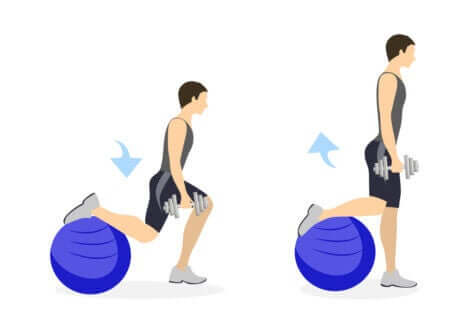
Bend your left knee, but don’t stick it out further than your left toes. You can either bring your arms straight out in front of you or hold weights in your hands. Lean forwards slightly. Focus on remaining centered and balanced. When you’ve bent your knee, straighten up again slowly and repeat. Make sure you do both legs evenly.
6. Thigh muscle exercises with a fitball
You may tend to forget to include exercises specifically for your thighs in your workout. But they’re very important for having sculpted thighs! For this exercise, stand with the fitball at your side and put that side’s foot on it.
Straighten your leg out to that side until it’s completely extended. Keep your balance and make sure you have a straight back, and your arms should be by your sides. When you’re in that position, bend the leg you’re standing on as if you were doing a squat, then straighten up. Do ten reps then change sides.
In summary, fitball exercises help you to have a complete workout, and to break up the routine with some variety. You can choose to focus on one specific area of your body in each training session or do a complete workout. In both cases, we recommend you ask for some guidance or supervision from a professional to get the most out of your training.
Also known as a Pilates ball, this giant rubber ball is an amazing ally for training, whether it’s at home or in a gym class. Fitball exercises are designed to be effective for everyone, and while some exercises are a little more complicated than others, you can always adapt them to suit your level.
Below, we’ll show you some of these exercises so you can include them in your workout. Among other advantages, they’ll help you to strengthen your whole body and will help to prevent injuries.
The best exercises with a fitball
These days, it’s clear that there are no valid excuses for not exercising. You don’t even have to go to the gym to get into shape; you can exercise right in your own home with just some basic items. The fitball is one of the most useful items for your home exercise kit, whether it’s for teens, adults, or older people.
There are a whole bunch of exercises you can do just on your own with a fitball, although it’s always a good idea to consult with an instructor to avoid injuries or muscle pain due to incorrect technique. Among the best options for training with a fitball, you can find the following exercises:
1. Glute bridge exercises using a fitball
This exercise is good for working your abs, glutes, and hamstring muscles. How can you do it? Lie down on an exercise mat face-up, and put your arms on the floor alongside your body for support with your palms facing downward. Put your heels on the fitball and roll it closer toward you by bending your knees. Your back should be flat on the floor.

Once you’re in that position, slowly raise your buttocks off the floor. Your legs should be slightly bent at the knees and your shoulder blades should give you support on the floor. Straighten your body until it’s in a straight line between your shoulders and your knees, making sure you don’t curve your back at any time. Hold the position for a few seconds and lower your back onto the floor again.
2. Sit-ups
This exercise is really just a classic sit-up with a twist, but the great thing about doing it using a fitball is that you make your core work to improve your balance as well. The first step is to lie on the fit ball on your back, with your glutes in the air. Bend your knees so they’re at about a 90-degree angle.
Put your hands behind your head and lift your chest and shoulders off the ball, keeping your lower back in contact with it, as you can see in the opening image. Look straight ahead and lower your chin onto your chest as much as possible. Relax, leaning back onto the fit ball. Do ten reps.
3. Squats
This is one of the best exercises to do with a fitball since it allows you to work your lower body very effectively. First, stand with your back to a wall and put the fitball between your back and the wall. The idea is to press it against the wall.

Once you’re in the starting position, bend your knees until they’re at around 90 degrees. Straighten up slowly. You can put your hands behind your head if it helps you with your balance.
Once you’ve got the hang of this exercise, you can make it a little more complicated. How? By using a couple of hand weights. Hold on to them and keep your arms hanging by your side while you do this exercise.
4. Push-ups
You can also do the famous push-ups with a fitball. This exercise is really a complete upper body workout.

To start, lie down face-down on your exercise mat. Straighten your arms and put your feet on the fitball. If you’re on your own, you might find it helpful to put the fitball up against a wall.
Keep your legs and back straight, with just your feet resting on the fitball. Now you just need to do the push-ups by straightening and bending your arms to complete the exercise.
5. Leg flexes
Exercises using a fitball are great to improve your posture, coordination, and balance. With this exercise, you’ll be working on all of those aspects.
Firstly, put the fitball against a wall and stand with your back to it. Then, stretch your right leg backward and rest it on the ball, with your knee in the air and your foot and ankle on the ball.

Bend your left knee, but don’t stick it out further than your left toes. You can either bring your arms straight out in front of you or hold weights in your hands. Lean forwards slightly. Focus on remaining centered and balanced. When you’ve bent your knee, straighten up again slowly and repeat. Make sure you do both legs evenly.
6. Thigh muscle exercises with a fitball
You may tend to forget to include exercises specifically for your thighs in your workout. But they’re very important for having sculpted thighs! For this exercise, stand with the fitball at your side and put that side’s foot on it.
Straighten your leg out to that side until it’s completely extended. Keep your balance and make sure you have a straight back, and your arms should be by your sides. When you’re in that position, bend the leg you’re standing on as if you were doing a squat, then straighten up. Do ten reps then change sides.
In summary, fitball exercises help you to have a complete workout, and to break up the routine with some variety. You can choose to focus on one specific area of your body in each training session or do a complete workout. In both cases, we recommend you ask for some guidance or supervision from a professional to get the most out of your training.
All cited sources were thoroughly reviewed by our team to ensure their quality, reliability, currency, and validity. The bibliography of this article was considered reliable and of academic or scientific accuracy.
- V. Bullo, M. Bergamin, S. Gobbo, J.C. Sieverdes, M. Zaccaria, D. Neunhaeuserer, A. Ermolao. 2015. The effects of Pilates exercise training on physical fitness and wellbeing in the elderly: A systematic review for future exercise prescription. Preventive Medicine. https://doi.org/10.1016/j.ypmed.2015.03.002.
(http://www.sciencedirect.com/science/article/pii/S0091743515000730) - Dragan Peric, Darko Stojanovic, Sonja Pavlovic-Veselinovic, Dejan Ilic, Toplica Stojanovic. 2015. THE EFFECTS OF AN ERGONOMIC EXERCISE PROGRAM WITH A PILATES BALL ON REDUCING THE RISK OF THE INCIDENCE OF MUSCULOSKELETAL DISORDERS. Physical Education and Sport. http://casopisi.junis.ni.ac.rs/index.php/FUPhysEdSport/article/view/1104
This text is provided for informational purposes only and does not replace consultation with a professional. If in doubt, consult your specialist.








